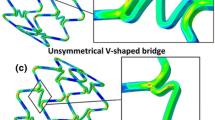Abstract
Endovascular stents are commonly used to manage arterial diseases such as Aortic Abdominal Aneurysm (AAA), aortic dissection and coarctation. The radial force the stent applies to the vessel must be large enough to resist stent migration, but not so large that the mechanical stimulus initiates adverse vessel remodeling. We employed two approaches to characterize the radial force of Gianturco stents: first, by applying an external pressure to the stent and, second, by measuring the force exerted by the stent when deployed. From the second approach, we determined the force exerted at various area reductions that correspond to clinically relevant diameter oversizings. In this study, stent stiffness was determined from the force-area reduction curves. Comparing similar stents of various diameters revealed that smaller diameter stent had greater radial force and stiffness than larger diameter stents. Comparing similar stents of various lengths revealed that stents with longer lengths (and greater number of wires) has greater force and stiffness. Overlapping two stents increased the force and stiffness to values greater than the sum of those parameters for the individual stents. These data may have important clinical implications for understanding the effect of oversized and overlapped stents on vessel mechanics.








Similar content being viewed by others
References
Agnoletti G, Bonnet C, Bonnet D, Sidi D, Aggoun Y. Mid-term effects of implanting stents for relief of aortic recoarctation on systemic hypertension, carotid mechanical properties, intimal medial thickness and reflection of the pulse wave. Cardiol Young. 2005;15(3):245–50.
Alderson H, Zamir M. Effects of stent stiffness on local haemodynamics with particular reference to wave reflections. J Biomech. 2004;37(3):339–48.
Bashar A, Kazui T, Washiyama N, Terada H, Yamashita K, Haque M. Mechanical properties of various Z-stent designs: an endovascular stent-grafting perspective. Artif Organs. 2003;27(8):714–21.
Berry JL, Newman VS, Ferrario CM, Routh WD, Dean RH. A method to evaluate the elastic behavior of vascular stents. J Vasc Interv Radiol. 1996;7(3):381–5.
Bush RL, Johnson ML, Collins TC, Henderson WG, Khuri SF, Yu HJ, Lin PH, Lumsden AB, Ashton CM. Open versus endovascular abdominal aortic aneurysm repair in VA hospitals. J Am Coll Surg. 2006;202(4):577–87.
Dobson G, Flewitt J, Tyberg J, Moore R, Karamanoglu M. Endografting of the descending thoracic aorta increases ascending aortic input impedance and attenuates pressure transmission in dogs. Eur J Vasc Endovasc Surg. 2006;32(2):129–35.
Duda SH, Wiskirchen J, Tepe G, Bitzer M, Kaulich TW, Stoeckel D, Claussen CD. Physical properties of endovascular stents: An experimental comparison. J Vasc Interv Radiol. 2000;11(5):645–54.
Dyet JF, Watts WG, Ettles DF, Nicholson AA. Mechanical properties of metallic stents: how do these properties influence the choice of stent for specific lesions? Cardiovasc Intervent Radiol. 2000;23(1):47–54.
Fallone BG, Wallace S, Gianturco C. Elastic characteristics of the self-expanding metallic stents. Invest Radiol. 1988;23(5):370–6.
Flueckiger F, Sternthal H, Klein G, Aschauer M, Szolar D, Kleinhappl G. Strength, elasticity, and plasticity of expandable metal stents: in vitro studies with three types of stress☆. J Vasc Interv Radiol. 1994;5(5):745–50.
Foley DP, Pieper M, Wijns W, Suryapranata H, Grollier G, Legrand V, de Scheerder I, Hanet C, Puel J, Mudra H, Bonnier HJ, Colombo A, Thomas M, Probst P, Morice M, Kleijne J, Serruys PW, MAGIC 5L Investigators. The influence of stent length on clinical and angiographic outcome in patients undergoing elective stenting for native coronary artery lesions; final results of the Magic 5L Study. Eur Heart J. 2001;22(17):1585–93.
Girndt M, Kaul H, Maute C, Kramann B, Kohler H, Uder M. Enhanced flow velocity after stenting of renal arteries is associated with decreased renal function. Nephron. 2007;105(2):84–9.
Haslach HW, Humphrey JD. Dynamics of biological soft tissue and rubber: internally pressurized spherical membranes surrounded by a fluid. Int J Non Linear Mech. 2004;39(3):399–420.
Hinchliffe RJ, Hopkinson BR. Development of endovascular stent-grafts. Proc Inst Mech Eng H, J Eng Med. 2007;221(6):547–60.
Lal BK, Hobson RW 2nd, Goldstein J, Chakhtoura EY, Duran WN. Carotid artery stenting: is there a need to revise ultrasound velocity criteria? J Vasc Surg. 2004;39(1):58–66.
Lossef SV, Lutz RJ, Mundorf J, Barth KH. Comparison of mechanical deformation properties of metallic stents with use of stress-strain analysis. J Vasc Interv Radiol. 1994;5(2):341–9.
Moore RD, Dobson G, McCune KH, Motamedi M. Endovascular options for thoraic aortic dissection. In: Matsumura JS, Pearce WH, Yao JST, editors. Trends in vascular surgery. Evanston, Illinois: Greenwood Academic; 2007. p. 191–212.
Moore J Jr, Berry JL. Fluid and solid mechanical implications of vascular stenting. Ann Biomed Eng. 2002;30(4):498–508.
Pasternak RC, Criqui MH, Benjamin EJ, Fowkes FG, Isselbacher EM, McCullough PA, Wolf PA, Zheng ZJ, American Heart A. Atherosclerotic vascular disease conference: writing group I: epidemiology. Circulation. 2004;109(21):2605–12.
Rodway AD, Powell JT, Brown LC, Greenhalgh RM. Do abdominal aortic aneurysm necks increase in size faster after endovascular than open repair? Eur J Vasc Endovasc Surg. 2008;35(6):685–93.
Snowhill P, Nosher J, Siegel R, Silver F. Characterization of radial forces in Z stents. Invest Radiol. 2001;36(9):521–30.
Vernhet H, Demaria R, Juan JM, Oliva-Lauraire MC, Senac JP, Dauzat M. Changes in wall mechanics after endovascular stenting in the rabbit aorta: comparison of three stent designs. Am J Roentgenol. 2001;176(3):803–7.
Wang R, Ravi-Chandar K. Mechanical response of a metallic aortic stent—Part I: pressure-diameter relationship. J Appl Mech-T Asme. 2004;71(5):697–705.
Acknowledgments
The authors would like to thank the Natural Sciences and Engineering Research Council of Canada (NSERC) for funding this work and Charles Imer for technical assistance in building the test apparatus.
Author information
Authors and Affiliations
Corresponding author
Rights and permissions
About this article
Cite this article
Johnston, C.R., Lee, K., Flewitt, J. et al. The Mechanical Properties of Endovascular Stents: An In Vitro Assessment. Cardiovasc Eng 10, 128–135 (2010). https://doi.org/10.1007/s10558-010-9097-9
Published:
Issue Date:
DOI: https://doi.org/10.1007/s10558-010-9097-9




